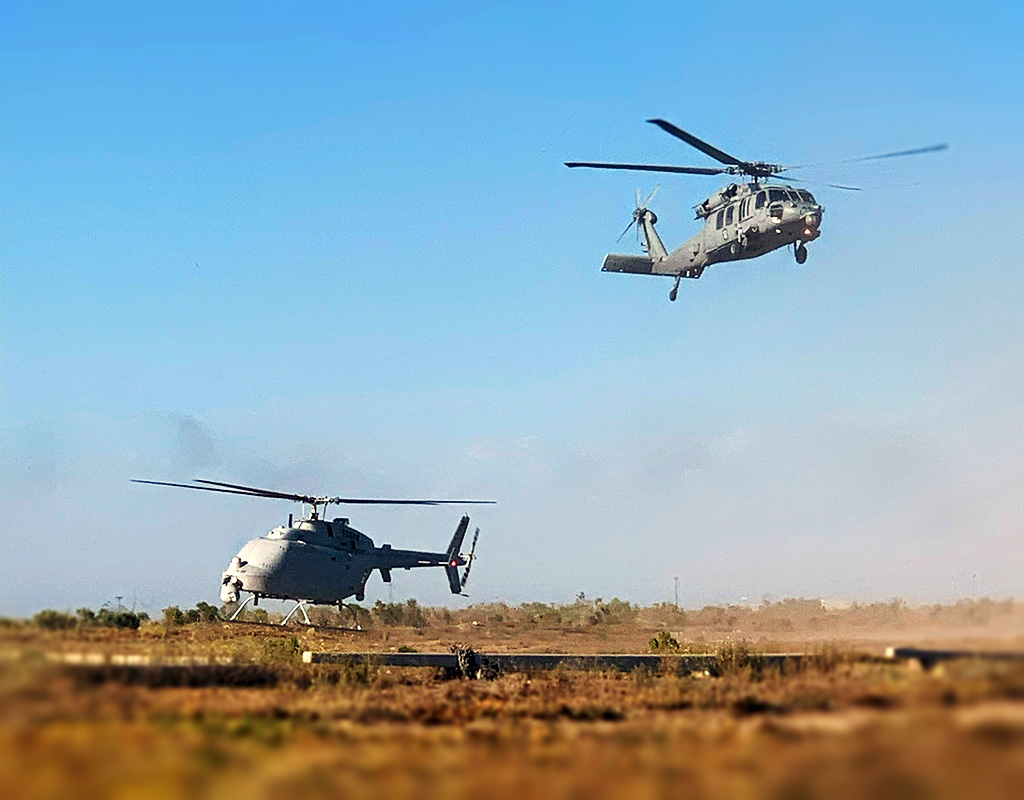
Northrop Grumman Corporation’s MQ-8C Fire Scout, the U.S. Navy’s autonomous, runway-independent helicopter system, has successfully completed operations under the Expeditionary Advance Base Operations (EABO) concept, providing persistent intelligence, surveillance, reconnaissance and targeting (ISR&T) capabilities in Exercise Resolute Hunter.
MQ-8C Fire Scout was launched from the vertical take-off and landing tactical unmanned air system (UAS) Maintenance Detachment at Naval Base Ventura County in Point Mugu, California, simulating a ship-based departure. The navy conducted a control system hand-off of the MQ-8C Fire Scout from Point Mugu to San Clemente Island, California, demonstrating the ship-to-shore transition capability of the platform in a maritime expeditionary environment.
“Fire Scout is the U.S. Navy’s only unmanned helicopter with the ability to deploy from a ship or land with ISR&T at the extended range required for future warfighting,” said Captain Dennis Monagle. “The system is vital in expeditionary use for situational awareness and critical decision-making.”
With the navy’s Portable Mission Control Station (MCS-P), the system was recovered and redeployed rapidly for operational flexibility. The portable MCS-P ground control station helps MQ-8C Fire Scout basing in austere locations on land, helipad operations in an advanced forward location, and logistics support from ship flight decks. With identical ship-based hardware, screen configuration and software, operations remain consistent across all ship classes.
“We are supporting MQ-8C deployments on littoral combat ships while assisting the navy with Fire Scout mission expansion efforts to include operations from other surface ships and shore-based sites,” said Lance Eischeid, director, Fire Scout program, Northrop Grumman. “This EABO demonstration further proves the flexible utility of Fire Scout for expeditionary use from land and across multiple ship classes.”
The MQ-8C Fire Scout is the U.S. Navy’s next-generation autonomous helicopter. It is based on the commercial airframe of the Bell 407, which gives the UAS more than double the range and endurance of the earlier MQ-8B, along with a significant increase in payload capability.

The U.S. Navy selected Northrop Grumman as the prime contractor to develop and produce up to eight next-generation MQ-8C Fire Scout unmanned air system in April 2012. It further awarded a $71 million contract to Northrop Grumman in March 2013 to build a further six MQ-8C helicopters.
Northrop Grumman received a $44 million contract from the U.S. Navy to build five more MQ-8Cs in April 2014. The authority plans to procure a total of 70 MQ-8C air systems as part of a rapid development effort.
Northrop Grumman awarded a contract to Summit Aviation in July 2012 to build and install Faraday cages on the MQ-8C Fire Scout unmanned helicopter. The cage protects the helicopter’s critical electronic components against strong electric fields and electromagnetic waves.
In August 2012, a $3.7 million contract was awarded to Cubic Defense Applications for the supply of a new multi-band digital data link system, which is used for transferring imagery and video from MQ-8C to the control station.
The final assembly of the UAS was performed at Northrop Grumman’s Unmanned Systems Center in Moss Point, Mississippi. The first upgraded unmanned MQ-8C was delivered to the U.S. Navy in July 2013 and its initial ground testing and engine runs were carried out in September 2013. The maiden flight of the first MQ-8C Fire Scout was conducted at Naval Base Ventura County in Point Mugu, California, in October 2013.
The second MQ-8C air system was delivered in November 2013 and completed its first flight in February 2014.
In May 2014, Northrop Grumman announced that the MQ-8C Fire Scout would undergo electromagnetic interference testing prior to the ship-based flights, to ensure its safe operation aboard the U.S. Navy ships. Precision-sloped landing tests of the helicopter were completed in August 2014. The first operational MQ-8C Fire Scout UAS was delivered to the U.S. Navy in early December 2014.
The unmanned helicopter completed its first sea-based series of flights from the USS Jason Dunham (DDG 109) guided-missile destroyer off the Virginia coast in December 2014. It performed 22 take-offs and precision landings on the ship during the tests.
The Fire Scout is equipped with a four-bladed main rotor and a two-bladed tail rotor. It has the ability to take off and land on prepared or unprepared landing zones. When operating from air-capable warships, the UAS can be controlled from the ship’s ground control station.
The unmanned helicopter measures 12.6m-long (41 feet), 2.7m-wide (9 feet) and 3.3m-high (11 feet), and has a rotor diameter of 10.7m (35 feet). Its maximum weight is 6,000 pounds, its internal payload capacity is 500 pounds. and its typical payload capacity is 300 pounds. It can carry a maximum sling load of 2,650 pounds.
The helicopter can be optionally equipped with maritime radar and a COBRA mine detector to meet future operational needs of maritime and ground forces.
The MQ-8C UAS is powered by a Rolls-Royce M250-C47E engine rated at 522 kW. The engine is equipped with a new dual-channel full-authority digital engine control (FADEC).
The MQ-8C Fire Scout UAS can be integrated with a range of payloads to provide warfighters with enhanced surveillance. Its payload systems include a laser range finder (LRF), communication relay, electro-optical/Infrared (EO/IR) sensor and an automatic identification system (AIS). The EO/IR sensor generates full-motion video and offers increased situational awareness in both day and low-light conditions.
The Fire Scout has a maximum speed of 135 km and a range of 1,227 nautical miles. It can operate at an altitude of 16,000 feet and has an endurance of up to 12 hours.
Other contractors involved in the MQ-8C Fire Scout programme are Bell Helicopter, General Electric Aviation, Sierra Nevada Corporation and Honeywell.

